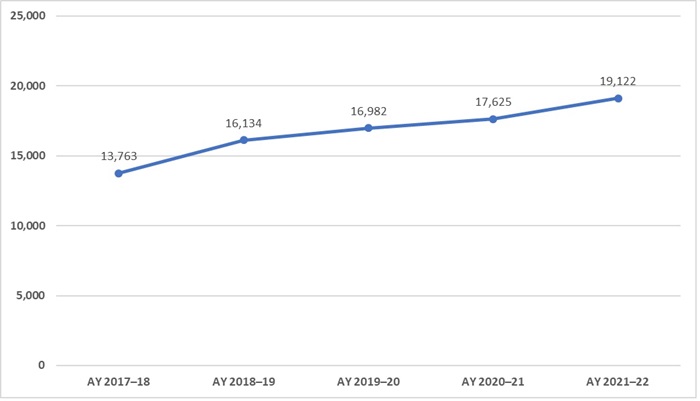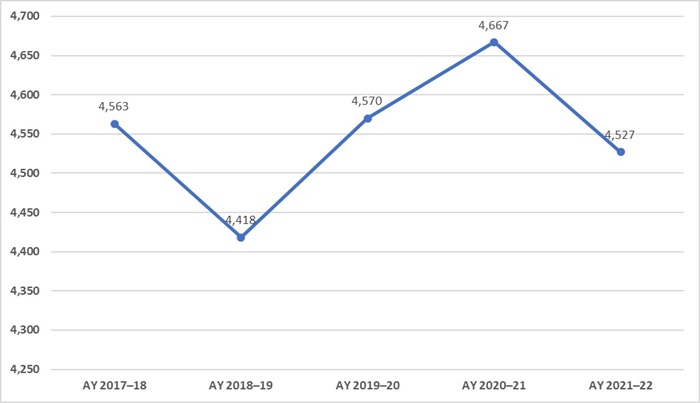Teacher pipelines and shortages have been a hot topic in Ohio the last several years. One of the biggest talking points has been that fewer students seem interested in the profession. A 2019 report from the Center for American Progress found that enrollment in teacher preparation programs fell nationally from 2010 to 2018, and that Ohio posted a decline of nearly 50 percent. State data released last year reflected the impact of these drops, with the number of newly licensed teachers having gradually declined since 2014.
Federal data released this spring, however, indicate that Ohio might have reason for hope. Title II of the Higher Education Act focuses on post-secondary programs that recruit, train, and develop teachers. It includes oversight for teacher preparation programs via state- and institution-level report cards. The 2023 State Reports released this spring include data from the 2021–22 academic year (AY), as that’s what was reported to the U.S. Department of Education by its deadline in October 2023. The interactive site containing this data is worth a look. The tools provided allow for a deep dive into any state, as well as the ability to compare states and yearly data changes.
For Ohio leaders, there are two findings worthy of note. First, Ohio is one of more than a dozen states to see an increase in enrollment at teacher preparation programs. In fact, as Figure 1 shows, the number of individuals enrolling in traditional teacher preparation programs has steadily increased over the five most recent years of data available. During the 2017–18 academic year, just shy of 14,000 prospective teachers enrolled in traditional preparation programs. By 2021–22, that number had climbed above 19,000.
Figure 1: Trend in Ohio’s traditional teacher preparation program enrollment

Second, although the number of teacher candidates enrolling in preparation programs is climbing, the number of program completers has been mostly flat. Figure 2 shows that the number of completers in 2021–22 is roughly the same as in 2017–18, with increases or decreases of roughly one hundred completers in the intervening years. That’s not too worrisome; it typically takes four years to complete a teacher preparation program, so the significant jump in enrollment during the 2020–21 and 2021–22 school years wouldn’t yet be reflected in completion numbers. But if next year’s data don’t reveal a noticeable bump in the number of completers to match the gradually increasing enrollment numbers, then policymakers and advocates will need to ask some tough questions of preparation programs.
Figure 2: Trend in number of program completers

There are some important caveats to consider along with these findings. As previously mentioned, the federal data highlighted above are from the 2021–22 academic year. Given the lag that’s typical with federal data collection efforts, we don’t have up-to-the-minute numbers through this source. It is possible that, over the course of the last two years, Ohio has experienced even more growth in enrollment in teacher preparation programs, or perhaps there’s been another worrisome dip. Either way, the recent enrollment bumps are good news, as they should translate to more teachers.
Ohio is also in desperate need of more and better data on its teacher workforce. Although federal data are helpful, they might not tell the whole story. There could be state or local data or context that paint a different picture. But if such data do exist, they’re not easily or readily available to policymakers or advocates. In a similar vein, unless the state starts to annually collect and publish data about teacher demand and vacancies, it will remain difficult to understand the true breadth and depth of teacher shortages. Without this information, policy solutions won’t be as timely and effective as they could be. Ohio lawmakers should consider addressing these issues in the upcoming budget.
Even with these caveats, though, there’s reason for hope. The federal numbers look promising for Ohio. And over the last few years, state lawmakers have taken some important steps to bolster the teacher pipeline. These include provisions to make teacher licensure more flexible, to expand the pool of substitute teachers, to establish a Grow Your Own Teacher Scholarship Program, and to create a Teacher Apprenticeship Program. There’s still more work to be done and plenty of ideas that should be enacted. But based on this available information, Ohioans have reason to feel a little less doom and gloom about teacher shortages going forward.




